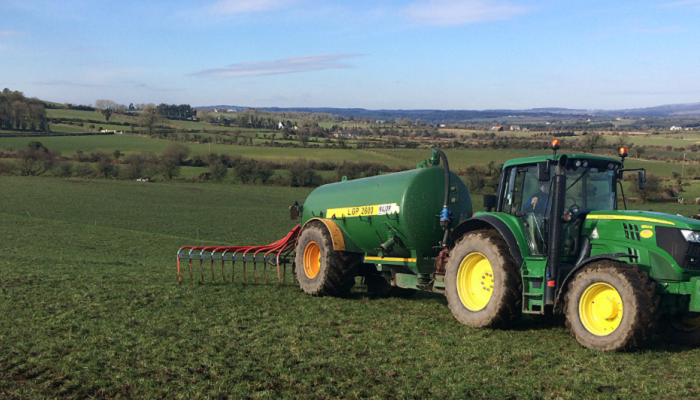13 January 2024
Time to appreciate the value of your cattle slurry

Joining Teagasc Dairy Edge host Dr Emma-Louise Coffey on a recent episode of the weekly podcast, Dr William Burchill, FBD Lecturer in Sustainable Agriculture at UCC, said that a rethink on the way slurry is managed on some farms is required.
With the slurry spreading period set to reopen in the various zones over the coming days and weeks, farmers have been reminded to appreciate the value of the cattle slurry produced on their farms, and to make appropriate decisions to ensure the best growth response is achieved from its application.
Farmers should treat slurry in a similar manner to chemical fertilisers, he noted, by timing applications to coincide with optimum growing conditions, to ensure a good response and efficient use of nutrients from slurry is achieved.
Highlighting the value of slurry, Dr Burchill said: “Two or three years ago, slurry was worth around €20 per 1,000 gallons – if we looked at the nitrogen, potassium and phosphorous in it.
“The value of slurry has actually almost increased two-fold. When the fertiliser prices were at their peak that was somewhere close to €40 per 1,000 gallons. At the moment now, it’s somewhere around the €30-35 per 1,000 gallons mark.”
The only source of P for some farms
Slurry is a significant source of nutrient on farms, with ~80% of its nutrient value being in the form of phosphorous (P) and potassium (K). The former, Dr Burchill noted, will play a vital role on some farms this year.
“For a lot of farms,” he said, “it may be the only source of phosphorous that we have available to us. For some farms that are in derogation and they have reasonably good levels of phosphorous in their soil samples already, they won’t have an allowance for phosphorous.
“So the only actual nutrient source for phosphorous on some farms will only be in the slurry that they have, so we really have to make sure that we make use of it and it’s applied in the appropriate time and the appropriate place to get the maximum benefit from it.”
The importance of testing slurry
The nitrogen (N), phosphorous and potassium values associated with cattle slurry were generated through a Teagasc survey conducted on farms of varying enterprise, system, shed types and tanks, a number of years ago, Dr Burchill explained. This survey produced an average value of 9 units of N, 5 units of P and 32 units of K contained within 1,000 gallons of cattle slurry.
As the above were average values, a degree of variability can exist between the nutritive content of cattle slurries from a farm-to-farm or even shed-to-shed basis. To name just a few, factors that can influence the nutritive value of slurry include its dry matter, the animals from which it is produced or the feeding regime the animals are exposed to.
Commenting on a slurry testing campaign conducted throughout the Dairygold Catchment which highlighted this variability, Dr Burchill said: “A major thing we found was there was massive variability particularly based on the type of tank the slurry came out of.
“What we generally found was the more covered the tank was, the higher the dry matter of the slurry was and, as a result, then you had a higher nutrient content.
“For example, we had some slurries coming in at closer to 12 units of nitrogen per 1,000 gallons. Whereas, maybe in more open tanks or open towers or even in lagoons, that nitrogen content could be down to maybe 6 or 7 units of nitrogen per 1,000 gallons – almost a two-fold difference in the nutrient content depending on the type of tank and literally how much water is getting into the tank and what level of dilution is there.”
Read more on the testing campaign conducted throughout the Dairygold Catchment here.
Given this variability, he noted that the on-farm testing of slurry is a practical step to maximise the efficient use of this fertiliser. The results of slurry testing, he said, can allow farmers to target slurry with higher P and K levels to silage ground, whereas slurry with a lower nutritive value for these elements can be applied to grazing swards, for which the requirement for P and K is typically lower.
For further details, listen to the Dairy Edge podcast below
